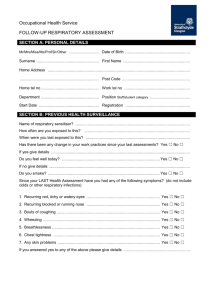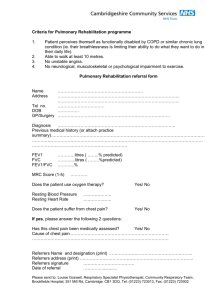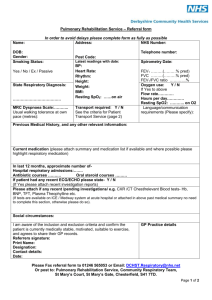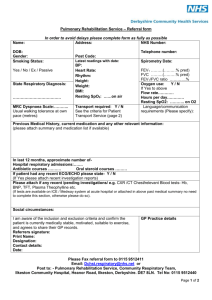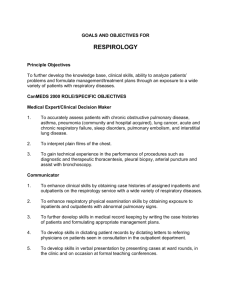1.The effect of two different training programs on pulmonary
advertisement
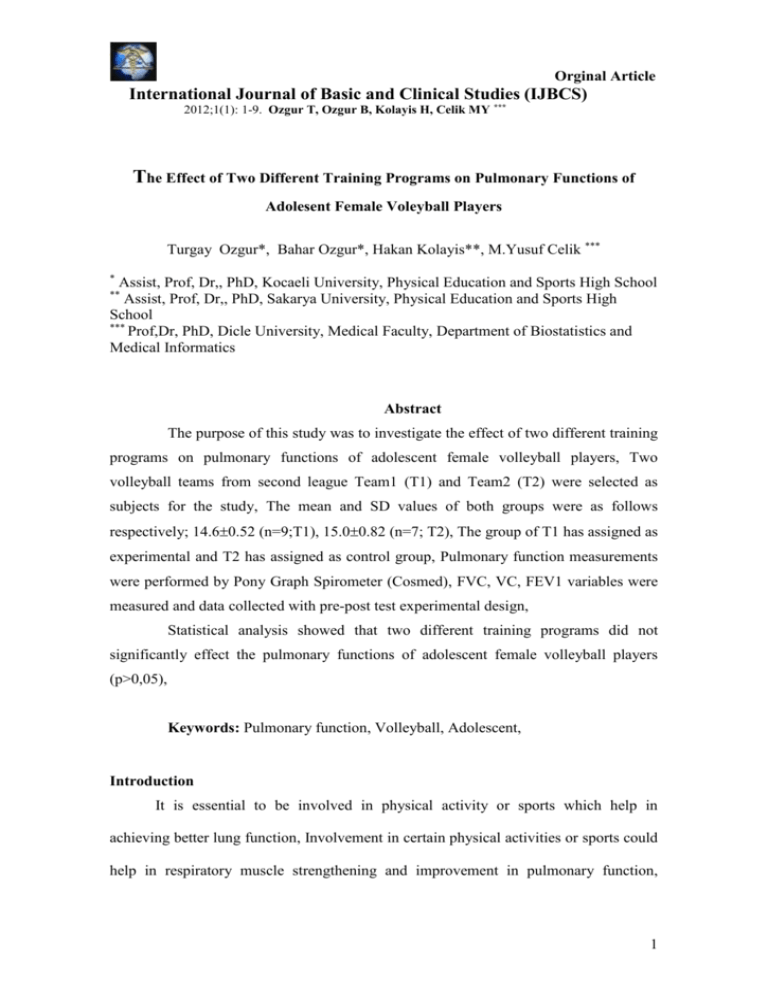
Orginal Article International Journal of Basic and Clinical Studies (IJBCS) 2012;1(1): 1-9. Ozgur T, Ozgur B, Kolayis H, Celik MY *** The Effect of Two Different Training Programs on Pulmonary Functions of Adolesent Female Voleyball Players Turgay Ozgur*, Bahar Ozgur*, Hakan Kolayis**, M.Yusuf Celik *** * Assist, Prof, Dr,, PhD, Kocaeli University, Physical Education and Sports High School Assist, Prof, Dr,, PhD, Sakarya University, Physical Education and Sports High School *** Prof,Dr, PhD, Dicle University, Medical Faculty, Department of Biostatistics and Medical Informatics ** Abstract The purpose of this study was to investigate the effect of two different training programs on pulmonary functions of adolescent female volleyball players, Two volleyball teams from second league Team1 (T1) and Team2 (T2) were selected as subjects for the study, The mean and SD values of both groups were as follows respectively; 14.60.52 (n=9;T1), 15.00.82 (n=7; T2), The group of T1 has assigned as experimental and T2 has assigned as control group, Pulmonary function measurements were performed by Pony Graph Spirometer (Cosmed), FVC, VC, FEV1 variables were measured and data collected with pre-post test experimental design, Statistical analysis showed that two different training programs did not significantly effect the pulmonary functions of adolescent female volleyball players (p>0,05), Keywords: Pulmonary function, Volleyball, Adolescent, Introduction It is essential to be involved in physical activity or sports which help in achieving better lung function, Involvement in certain physical activities or sports could help in respiratory muscle strengthening and improvement in pulmonary function, 1 Orginal Article International Journal of Basic and Clinical Studies (IJBCS) 2012;1(1): 1-9. Ozgur T, Ozgur B, Kolayis H, Celik MY *** Change in physical activity is associated with change in cardio respiratory fitness (1). Kamijo K et al,examined the effects of a 9-month randomized control physical activity intervention aimed at improving cardio respiratory fitness on changes in working memory performance in preadolescent children relative to a waitlist control group. The results indicate that increases in cardio respiratory fitness are associated with improvements in the cognitive control of working memory in preadolescent children (2). Regular and long term physical education increases the cardio respiratory functions (3). Besides it develops muscular organism muscle strength, locomotors flexibility, pulmonary capacity, neuromuscular coordination (4). Respiratory volume and respiratory frequency increases during physical exercise and this increase the respiratory minute volume and carries O2 to organism that it requires. The physiological harmony of the respiratory system that would supply necessary and sufficient O2 for the exercises is a necessity of this mechanism. The increasing level of vital capacity and improvement of respiratory muscles are limited with the extension ability of lung and thorax wall and elasticity of bronchus. Vital capacity can also differ due to factors like position, body measures, age and sport type (5). In the current study, it was aimed to investigate the effect of 6 weeks of two different training programs on the respiratory parameters of youth female volleyball players. Materials and Methods Subjects: Team1 (n=9) was selected as experimental group and Team2 (n=7) was attended to the study as control group. Method: Pulmonary functions measured using with Pony Graph (Cosmed) Spirometer. 2 Orginal Article International Journal of Basic and Clinical Studies (IJBCS) 2012;1(1): 1-9. Ozgur T, Ozgur B, Kolayis H, Celik MY *** Values for vital capacity (VC) forced vital capacity (FVC) and forced expiratory volume at 1st vital (FEV1) were measured, Data was collected using pre-post test experiment format. Pulmonary function was measured in a standing position, wearing a nose clip, Each subject was tested four time with a 4-5 min interval between tests, The subjects normally performed one practice maneuver followed by the four trials, The average of the three best trials was taken as the value for each measurement. T1 Volleyball Training Program: A volleyball standard training program of 6 weeks long, 4 days/week, 1,5 hours/day carried out with a content of technical and tactic skills. T2 Volleyball Training Program: A volleyball standard training program of 6 weeks long, 4 days/week, 1,5 hours/day carried out with a content of technical and tactic skills and condition training, Additionally as of first week 20-25 minutes aerobic endurance training carried out with a 65-75 percent of maximum HR-RestHR 2 days/week. Pre-test: 1 day before the training program starts, at 10:00 am after the standard warm-up session, Post test: At the next day of the end of 6 weeks with same conditions of pre-test. Statistical Analysis Mean and standard deviation (SD) were calculated for continuous variables. The normality of the variables was analyzed by Kolmogorov–Smirnov test. Student’s t test for two independent and related samples was used separately. Two-sided p values were considered statistically significant at p≤0.05. Statistical analyses were carried out by using the statistical packages for SPSS 15.0 for Windows (SPSS Inc., Chicago, IL, USA). 3 Orginal Article International Journal of Basic and Clinical Studies (IJBCS) 2012;1(1): 1-9. Ozgur T, Ozgur B, Kolayis H, Celik MY *** Results Table 1 shows the results of descriptive statistics for both groups. Table 2 shows the results of pulmonary functions for the comparison of T1 before and after training. Pulmonary functions for the comparison of T2 before and after training was presented by Table 3. The results for the comparison of respiratory functions in the experimental and control groups before training were shown by Table 4 and Table 5 also shown the results for the comparison of respiratory functions in the experimental and control groups after training. Table 1: Descriptive statistics for both groups T1 (n=9) and T2 (n=7) Variable N Minimum Maximum 9 162 174 Height (cm) 7 158 177 9 52 67 Weight(kg) 7 50.8 72 Mean 168.5 169.9 60.2 57.06 SD 4.35 6.76 5.41 7.31 Table 2: Pulmonary functions, comparison of T1 before and after training (n=9). Variable Minimum Maximum Mean SD P 0.441 FVCPre 2.92 4.31 3.60 0.44 FVCPost 3.04 4.28 3.65 0.39 FVC%Pre 85 133 105.44 14.34 FVC%Post 89 126 105.22 11.60 FEV1Pre 2.61 3.33 3.04 0.23 FEV1Post 2.76 3.51 3.15 0.23 FEV1%Pre 85 113 99.44 10.96 FEV1%Post 90 123 102.44 10.71 VCPre 1.55 2.61 1.99 0.33 VC Post 1.14 2.73 2.01 0.53 VC%Pre 45 70 58.33 9.24 VC% Post 33 77 58.55 14.92 0.342 0.068 0.138 0.953 0.953 Table 3: Pulmonary functions, comparison of T2 before and after training (n=7) Variable FVCPre FVCPost Minimum Maximum 2.73 4.1 3.15 3.97 Mean 3.5 3.60 SD 0.48 0.27 P 0.31 4 Orginal Article International Journal of Basic and Clinical Studies (IJBCS) 2012;1(1): 1-9. Ozgur T, Ozgur B, Kolayis H, Celik MY *** FVC%Pre FVC% Post FEV1Pre FEV1 Post FEV1%Pre FEV1% Post VCPre VC Post VC%Pre VC% Post 73 87 2.71 2.94 82 91 1.19 1.39 32 38 118 115 3.79 3.74 114 111 2.68 2.86 91 82 99.28 104.42 3.26 3.29 103.85 105.85 2.07 2.262 59.71 65.42 13.61 10.59 0.38 0.313 11.00 7.380 0.50 0.452 18.05 14.68 0.108 0.893 0.416 0.611 0.398 Table 4: Comparison of respiratory functions in the experimental and control groups before training Variable FVC FVC% FEV1 FEV1% VC VC% P 0.874 0.634 0.223 0.368 0.791 0.874 Tablo 5: Comparison of respiratory functions in the experimental and control groups after training Variable FVC FVC% FEV1 FEV1% VC VC% P 0.832 0.915 0.366 0.287 0.368 0.266 Discussion The result of the present study demonstrate that 6 weeks of two different volleyball training have not effected the pulmonary functions adolescent female volleyball players, It may be resulted from the relatively short (6 weeks) training period. 5 Orginal Article International Journal of Basic and Clinical Studies (IJBCS) 2012;1(1): 1-9. Ozgur T, Ozgur B, Kolayis H, Celik MY *** The effect of volleyball training on pulmonary functions has not been well reported. Although the effect of endurance and swimming trainings have been fairly well documented. Pulmonary functions were not significantly difference between experimental and control group. Pulmonary functions also were not significantly difference before and after training. The data obtained for experiment and control groups were similar with the predicted values (6). Physical characteristics in the present study show similarity with the literature concerning height and weight values (7-11). During physical exercises muscles need more oxygen, In order to supply muscles with more oxygen respiratory system represents a physiological adaptation meaning that parallel with the O2 requirement level, respiratory system increases the O2 that it provides to the organism, But regardless of the O2 amount taken the utility capacity of muscles always happens to be constant with a certain maximum level (MaxVO2), This can be explained depending on the reason that the pulmonary system can transport a limited amount of O2 to tissues and muscles even this amount differs depending on age, Heart can pump a limited amount of blood to periphery per minute, As a result, it would not be erroneous to conclude that the deterministic parameter for the efficiency during an activity of an healthy adult is the respiratory system (4). In 1996 Gonenc S et al, made a 4 weeks long study with 13 girls (average 9,1 ±1,4) and 15 boys (8,1±2,1) to examine the effects of swimming exercises. At the end of the study no significant difference was found between VC and MVV values. The reason was considered to be the short duration and low intensity. Concerning VC values similar results have been found in our study. Though the sport activities were not similar results may be transferred to volleyball training and its’ effects. It has been reported by Farrel (1981) in adults that FVC increased after only in 8 weeks of endurance training. Addition to that it has been suggested that ventilator muscles can increase their strength and endurance capacity in response to specific training (12). Our findings were also in accordance with the literature, 6 weeks of volleyball training, whether it features an aerobic endurance session or not have not 6 Orginal Article International Journal of Basic and Clinical Studies (IJBCS) 2012;1(1): 1-9. Ozgur T, Ozgur B, Kolayis H, Celik MY *** effected the pulmonary functions, It appears that 8 weeks training periods are necessary to achieve increase in pulmonary functions (14). Concerning the increase in FEV1 Courtiex et al (1997) have reported that intensive swimming training improves not only the conductive properties of the large airways but also those of the small airways. Similar results have not been found in this study. It appears that the training duration was not long enough to provide these adaptations (15). In 1995 Gimenez M, et al carried out two different endurance training programs for 8 weeks, They have observed significant improvement in pulmonary function values in both groups due to two different programs (16). Though the training programs were different in means of aerobic endurance loads, no significant difference has occurred, In order to observe the permanent changes besides the immediate respond of pulmonary functions to training program, longer experimental studies (8 weeks or longer) should be planned. The analysis of data showed that 6 weeks long two different volleyball training programs did not make a difference on pulmonary functions of female volleyball players. References 1) Hulke SM, Phatak MS: Effect of endurance training on lung function: a longitudinal study, Int J Biol Med Res, 2011; 2(1): 443-446 2) Kamijo K, Pontifex MB, O’Leary KC et al,, The effects of an afterschool physical activity program on working memory in preadolescent children, Developmental Science, Blackwell Publishing Ltd, Online, 2011; 1–13 3) Türkmen S,, Uysal N,, Kayatekin M,, Düzenli Yüzme Eğitimi Alan Ambulans Ve Acil Bakım Teknikerliği Programı Öğrencilerinin Solunum Parametrelerinin Değerlendirilmesi, Hacettepe University Swimming Science and Technology Magazine, Onay Ajans, Ankara 1998; 5 (20) 4) Metin G,, Beyaz M,, Yücesir İ, Ve ark, Aynı Yaş Gurubundaki Milli Yüzücülerle Milli Olmayan Yüzücülerin Dinamik Ve Statik Akciğer 7 Orginal Article International Journal of Basic and Clinical Studies (IJBCS) 2012;1(1): 1-9. Ozgur T, Ozgur B, Kolayis H, Celik MY *** Hacimlerinin Karşılaştırılması, Hacettepe University Swimming Science and Technology Magazine, Onay Ajans, Ankara, 1998; 5 (18) 5) Erkmen, N, Kaplan T, Taşkin H, Profesyonel Futbolcuların Hazırlık Sezonu Fiziksel ve Fizyolojik Parametrelerinin Tespiti ve Karşılaştırılması, SPORMETRE Beden Eğ itimi ve Spor Bilimleri Dergisi, 2005; III (4) 137-144 6) Zapletal A, Samanek M, Paul T, Lung function in children and adolescents, Methods, reference, values, Prog Respir Res Karger, Basel 1987; 22:220 7) Chang, C,K,, H,L, Lin, and H,F, Tseng,, The side-to-side differences in bone mineral status and cross-sectional area in radius and ulna in teenage Taiwanses female volleyball players, Biol, Sport, 2008; 25:69–76, 8) Grgantov, Z,, R, Katic, and V, Jankovic, Morphological characteristics, technical and situation efficacy of young female volleyball players, Coll, Antropo, 2006; 30:87–96 9) Leone M, Lariviere G and Comtois AS, Discriminant analysis of anthropometric and biomotor variables among elite adolescent female athletes in four sports, J Sports Sci, 2002; 20:443–449 10) Melrose DR, Spaniol FJ and Bohling ME et al. Physiological and performance characteristics of adolescent club volleyball players, J, Strength Cond, Res,, 2007; 21:481–486, 11) Stamm R, Veldre G, Stamm M et al, Dependence of young female volleyballers’ performance on their body build, physical abilities, and psycho-physiological properties, J Sports Med Phys Fitness, 2003; 43:291–299 12) Leith DE, Bradley M Ventilatory muscle strength and endurance training, J Appl Physiol 1976; 41: 508-516 13) Gonenc S, Kayatekin M ve Acikgoz O ark. Dort haftalik yüzme eğitim kursunun çocuklarda vucut kompozisyonuna ve solunum parametrelerine etkisi, / (The effects of four weeks swimming training course on body composition and respiratory parameters in children,), Spor hekimligi dergisi/Turkish journal of sports medicine (Izmir); Mar 1996; 31 (1), 27-33 8 Orginal Article International Journal of Basic and Clinical Studies (IJBCS) 2012;1(1): 1-9. Ozgur T, Ozgur B, Kolayis H, Celik MY *** 14) Farrel PA Maximal expiratory flow-volume relationship before and after eight weeks of endurance training, J Sports Med 1981; 21:145-149 15) Courteix D, Obert P and Lecoq AM et al. Effect of intensive swimming training on lung volumes, airway resistances and on the maximal expiratory flow-volume relationship in prepubertal girls, Eur J Appl Physiol 1997; 76: 264 – 269 16) Gimenez M, Predine E, Entrainement d'enfants normaux scolarises avec deux methodes differentes dont l'epreuve en creneaux, / (Training of normal school children with two different protocols including a square wave exercise,), Medecine du sport (Paris); dec 1995; 69 (5), 280-286 9
